
Carpet padding makes your carpet feel extra comfortable and protects your floors from damage, but how much does carpet padding cost? Let’s look at the numbers.
Two carpet heavyweights battle to be the best


Polyester costs $1 to $3 per square foot, and nylon costs $2 to $5 per square foot, making polyester the better option for people on a budget.
Nylon is more durable and resilient than polyester, so it’s perfect for high-traffic areas and homes that get a lot of visitors.
Polyester is more stain-resistant and colorfast than nylon, making it a solid choice for homes where spills happen often.
Polyester often needs to be replaced sooner than nylon, so the higher price of nylon is worth it for some people.
Nylon and polyester carpet have a few things in common since they’re both types of synthetic carpet fibers that can add warmth and coziness to your home. However, there are also some notable differences—particularly in terms of cost and durability. If you’re trying to choose between nylon versus polyester carpet, keep reading to learn about the pros and cons of each one to help you decide which one is right for your home.
Nylon and polyester carpet are common types of synthetic carpet. They’re both durable, soft, and available in a variety of colors, styles, and patterns. However, there are important differences between the two. For one, nylon is more resilient and long-lasting than polyester, making it the more expensive option. On the other hand, polyester holds up better against stains and fading.

Known for its durability and resilience, nylon was the first-ever synthetic carpet fiber. Today, it’s the most popular type of carpet on the market, used in both homes and commercial buildings. Nylon carpet holds up well under heavy weight and bounces back easily after pressure is applied. It’s also soft and comfortable to walk on.
| Pros | Cons |
|---|---|
| Highly durable | Pricier than polyester |
| Good for high-traffic areas | Needs yearly steam cleaning |
| Resists mold and mildew | Not as stain-resistant |
Best for:
Homes with kids or pets
Busy households with lots of foot traffic
People with allergies or sensitivities who need a mold-resistant carpet
For many people, durability is the most attractive feature of nylon carpet. With proper care, this synthetic carpet can last up to 15 years. Nylon carpet is also highly resilient, making it one of the best carpet options for stairs and other high-traffic areas. Even after being stepped on repeatedly, it retains its height and shape well.
Nylon carpet fibers resist mold and mildew, which is ideal if you’re sensitive to mold or have allergies. Plus, if you’re concerned about spills and water damage, you can purchase nylon carpet that’s been treated to be stain-resistant.
The downside of nylon’s longevity is that it costs more to install than less durable materials (like polyester). However, the higher upfront price might even out over the long run since you’d likely have to replace a polyester carpet before a nylon one.
Nylon’s upkeep requirements are another potential drawback. To keep a nylon carpet in good shape, you’ll need to steam clean it once per year. It’s also worth mentioning that nylon isn’t naturally stain-resistant, and it’s more absorbent than polyester. To prevent your carpet from soaking up spills, you’ll need to apply a stain-resistant treatment.

Polyester carpet is another synthetic carpet fiber. It’s less expensive than nylon and most other types of carpet, so it’s worth considering if you’re updating your flooring on a budget. Some types of polyester are made from recycled materials, which is great if you’re looking to minimize your environmental impact.
| Pros | Cons |
|---|---|
| More affordable | Not as durable |
| Colors don’t fade easily | Shows wear and tear quicker |
| Better at resisting stains | Gets crushed and flattened easier |
Best for:
People looking for a cost-effective carpet option
Environmentally-conscious consumers
Anyone seeking a soft carpet for low-traffic areas (like bedrooms)
When comparing nylon versus polyester carpet, polyester’s biggest advantage is its price. It costs quite a bit less than nylon (in some cases, it’s half as expensive). On top of that, polyester is more stain-resistant and less likely to absorb liquid than nylon. Plus, polyester holds color well and won’t fade easily.
Between polyester and nylon, polyester is the more eco-friendly carpeting choice since much of it is made from recycled plastic bottles. If this is important to you, keep an eye out for carpet made from polyethylene terephthalate (PET) polyester.
Polyester isn’t as tough as nylon when it comes to withstanding foot traffic or weight from furniture. It crushes more easily than nylon, so if there’s regular pressure on top of your polyester carpet, the fibers are likely to flatten and lose a lot of their height.
Because of these factors, this type of flooring may show signs of wear and tear quicker than nylon and other, more durable materials. Plus, you might need to replace the carpet sooner.
So, is nylon or polyester carpet better? It depends on the category. Here’s how the two carpet fibers compare in appearance, durability, price, and more.
If you aren’t too familiar with different carpet fibers, you might not be able to tell the difference between nylon and polyester carpet. However, nylon wins here because it springs back into shape faster than polyester after you apply pressure to it.
While both types of carpet are durable, nylon is sturdier and more long-lasting than polyester.
Polyester is the clear winner in this category. On average, polyester carpet costs $1 to $3 per square foot, while nylon costs $2 to $5 per square foot.
Both nylon and polyester carpets come in a range of colors and designs, so you shouldn’t have much trouble finding one that suits your style.
From average costs to expert advice, get all the answers you need to get your job done.

Carpet padding makes your carpet feel extra comfortable and protects your floors from damage, but how much does carpet padding cost? Let’s look at the numbers.

The cost to carpet stairs depends on the number of stairs, material choice, and staircase type. Read on to calculate your project expenses

Not only are carpet tiles easier to install than carpet, but they’re often more affordable. So, how much does carpet tile installation cost? Let’s take a look.

You can extend a carpet's life with regular cleaning, but one day, you will need a carpet replacement. These signs indicate when to replace your carpet.

The best carpet for stairs is durable and suited for high-traffic environments. However, they aren’t as soft and can be more expensive. Read on to learn more.

Twist is a soft, durable, and versatile carpet, but it does have its drawbacks. Consider these twist carpet pros and cons for your next flooring project.